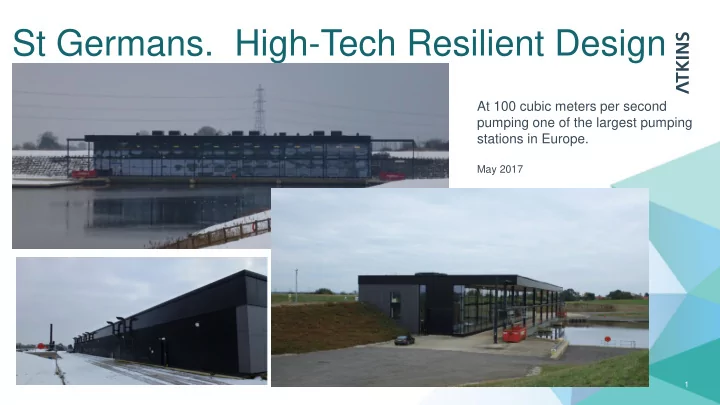

St Germans. High-Tech Resilient Design At 100 cubic meters per second pumping one of the largest pumping stations in Europe. May 2017 1
Scheme Objectives Provide a state of the art facility able to run automatically with a design capacity of 100cumec; • Resilient design • Reduce the effects of siltation which was a problem with the old station • Fully automated and control linked with upstream drain levels retaining the years of experience of the manual tweaks • High tide levels of 1 in 200 years • Design life: MEICA 20 to 40 years Civils 75 years • Fish and Eel friendly 2
Station Location. Resilient design to prevent silt build-up Multiple locations were considered to build the station The design of the outlet was designed to reduce the build up of silt and to reduce the turbulence. After researching other pumping stations in the UK and Holland, the best way is to keep the approach straight. 3
Gravity By-Pass or not. Gravity by passes Previous pumping station at 70 cumec with 2 water cooled diesel engine drives and 2 converted to fixed speed electric motor drives 4
Resilient Design for Flood Defence Breach In major flood events in the UK and around the world, the flood waters have disabled many pumping stations such that once the storm is over, the pumps are no longer available to pump the flood water away. Tidal defences flood breach analysis to determine the maximum level of flood waters that could get behind (i.e. upstream) of the pumping station and then set all the critical pumping components above that level. 5
Pump Type 6
Pump Type 7
Motor voltage, motor and station cooling, power supply, Variable speed drives and their cooling, flap valve removal. 8
Drain hydraulic gradient St Germans PS control Bodsey Bridge 9
Pumping at low tide 1. Average power per pump over the tide cycle = 500kW. Initially set to run at night at the lowest Tariff. Average annual power cost (ex avail charge) = £61,300 2. Average power pumping on the low tide = 150kW. Changed to run at low tide regardless of day or night. Average annual power cost (ex avail charge) = £27,008 10
NPV savings over 25 and 50 years NPV projected saving over 25 NPV projected saving over 50 Key design decision years in £k years in £k 1 Design in line with drain 197.5 259.2 2 Removal of gravity by pass 265.8 270.7 3 Flood breach consideration -50.0 170.5 4 Pump type 26.6 35.9 5 Motor voltage 1,579.6 2,073.5 6 Motor and station cooling 160.7 177.6 7 Power supply strategy 1,085.8 1,268.9 8 Use of VSDs 520.7 524.2 9 VSD cooling 123.5 137.1 10 Ease of removal of flap valves 4.5 8.6 11 Automated control 2,031.1 2,666.1 Total £5,945.8k £7,592.3k 11
Questio ions?
Recommend
More recommend